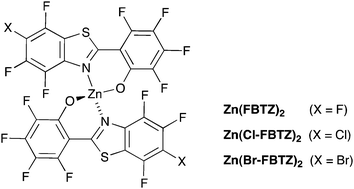Enhancing the sensitization efficiency of erbium doped organic complexes by heavy halogen substitution†
Abstract
Lanthanide complexes with organic ligands have been of interest due to the possibility of sensitising lanthanide ions through the antenna effect. We have recently shown that the zinc(II) salt of 2-(3,4,5,6-tetrafluoro-2-hydroxyphenyl)-4,5,6,7-tetrafluorobenzothiazole, Zn(FBTZ)2, can provide very high levels of sensitisation to organic erbium complexes whilst maintaining very high quantum yields for the erbium near-infra-red luminescence. We now report the spectroscopic properties of the zinc(II) salts of 2-(3,4,5,6-tetrafluoro-2-hydroxyphenyl)-6-chloro-4,5,7-trifluorobenzothiazole and 2-(3,4,5,6-tetrafluoro-2-hydroxyphenyl)-6-bromo-4,5,7-trifluorobenzothiazole. The substitution of a single chlorine atom into the chromophore is sufficient to double the sensitisation efficiency compared to the fully fluorinated chromophore. This result implies a 50% reduction in the pump intensity needed to achieve population inversion in the erbium ions.



 Please wait while we load your content...
Please wait while we load your content...